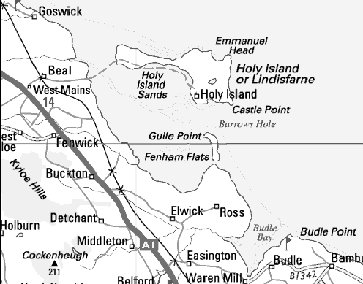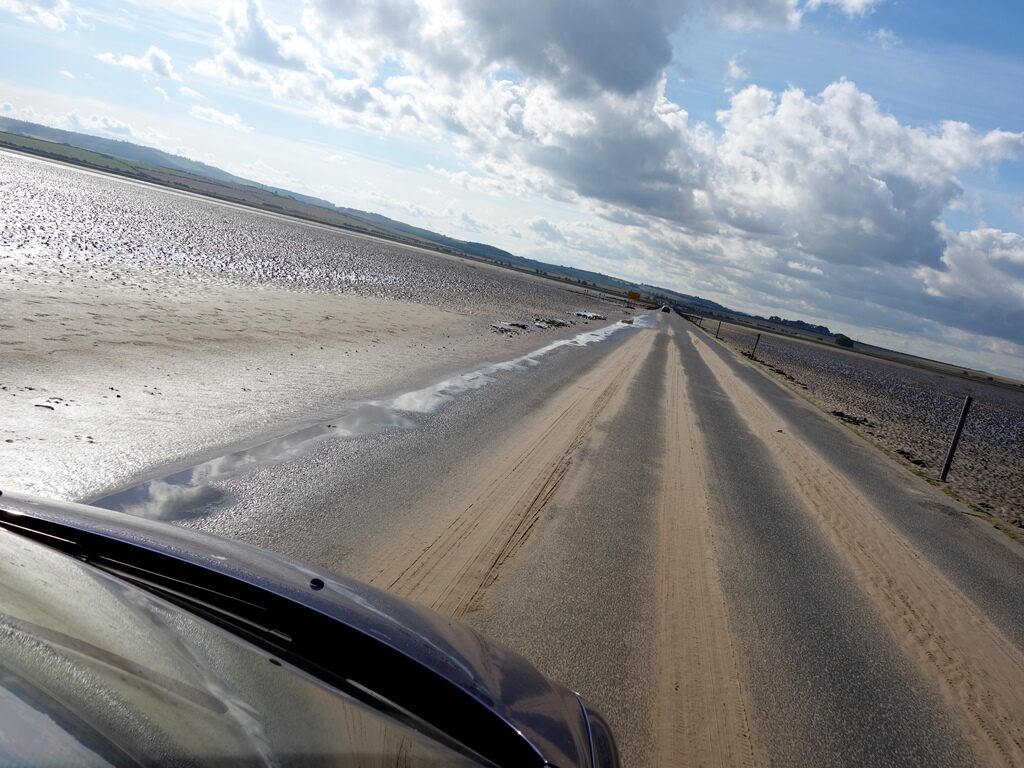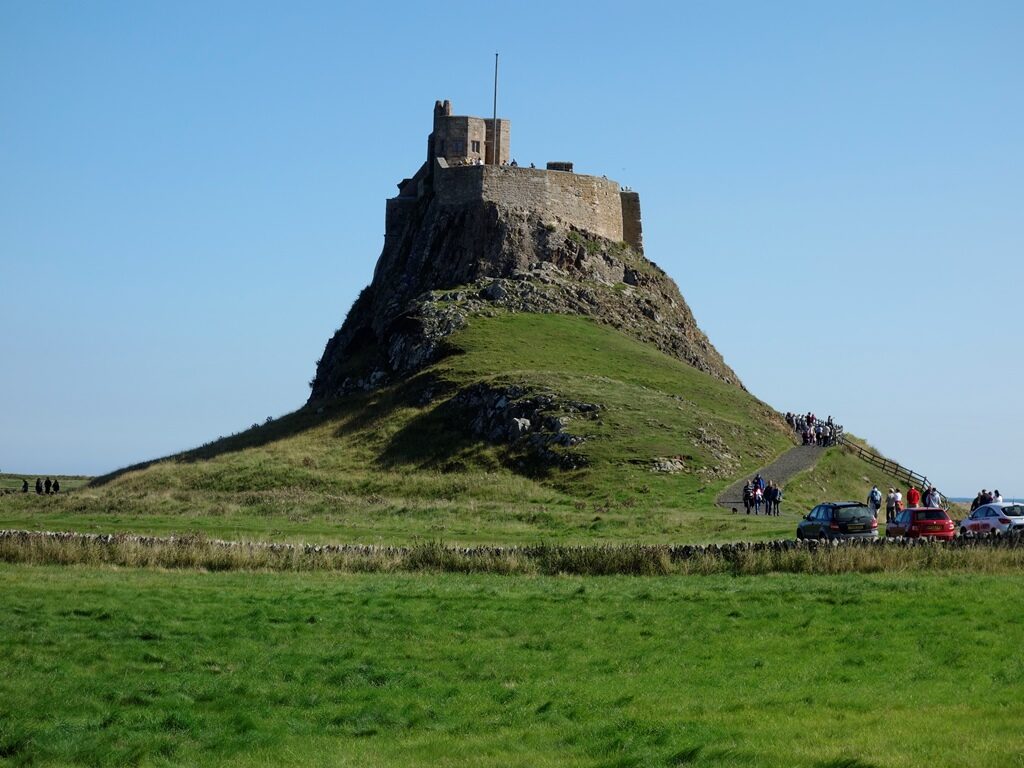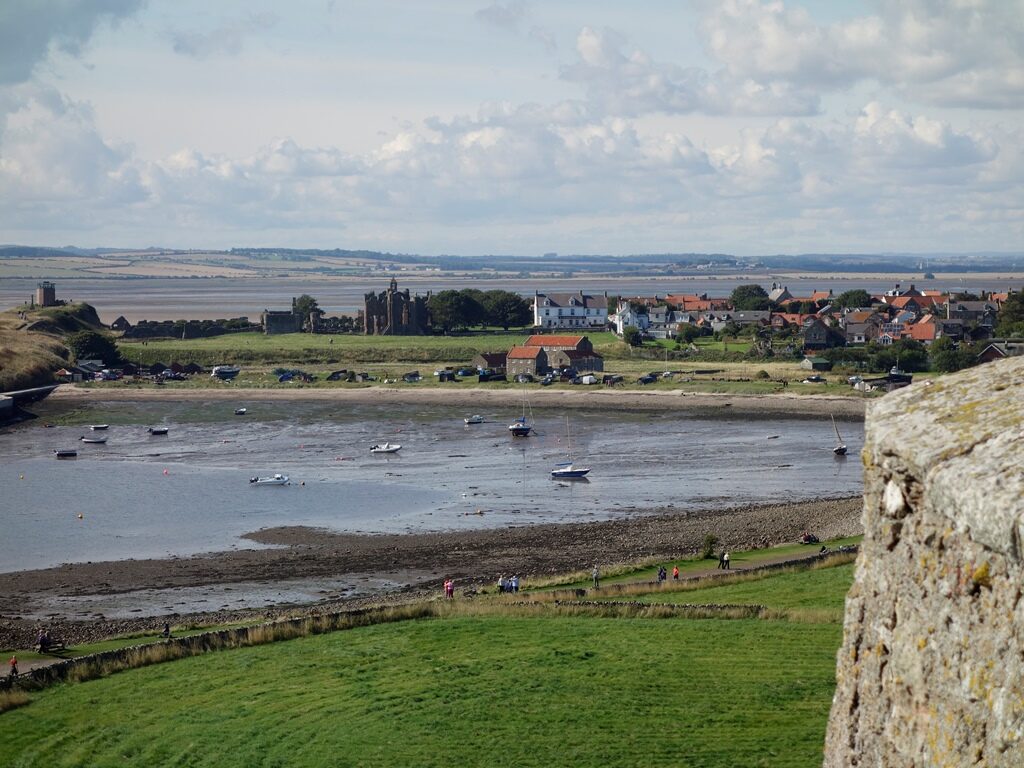By Peter Porteous
We had talked of going to see Lindisfarne and in one September past, we managed to get there! It is 400 miles from Axminster so after staying with friends for the first night and a hotel in York for the next, we arrived on the North Sea coast of Northumberland for a week’s holiday. Lindisfarne or ‘The Holy Isle’ is twelve miles South East of Berwick-Upon-Tweed and once home to the medieval monastery of St Aidan and St Cuthbert.

The main part of Lindisfarne is about a mile square and lies a mile off-shore. The route across the sands is a tarmacked causeway which is exposed at low tide for about six hours twice each day. There is a population of about 200 on the island which, as you might imagine, is focused on tourism with the three main attractions being Lindisfarne Castle (National Trust), Lindisfarne Priory and museum (English Heritage) and the Lindisfarne Centre (Local Community Development Trust). In the summer it gets crowded with thousands visiting by day in the height of summer.

Much of what we know of Lindisfarne comes from St Bede who lived less than 100 years after the founding of the Church and Priory in AD 635. The king of Northumbria was Oswald (634 – 642) who had been brought up in Celtic Iona and was reportedly a pious man. The local Anglo-Saxon population had reverted to paganism and the king sent for Aidan, an Irish Monk from Iona to re-introduce Christianity. Aidan became the first Bishop and Lindisfarne became the seat of his Northumbrian Diocese where his relationship with Oswald at Bamburgh Castle were cordial. Aidan was an inspired missionary and the Island became an important centre for the evangelization of Northern England. Aidan died at the church in Bamburgh Castle in AD 651.
In AD 665 St Cuthbert, an Anglo-Saxon monk from Melrose Abbey arrived at Lindisfarne as the Prior. It took 4 days of walking a route now called Cuthbert’s way, a pilgrimage route of about 65 miles which apparently is very beautiful. Cuthbert was a powerful evangelist and travelled the length of Northumbria and was held in very high regard. He became Bishop in Lindisfarne but chose to live the life of a hermit on the Farne Isles where he died. In AD 687.
Although from the Celtic church, it was St Cuthbert who accepted the dominance of the Roman tradition which was agreed at the Synod of Whitby in AD 664 and helped to settle the rift between the Celtic and Roman traditions. After his death, the island became a place of pilgrimage and within 30 years St Cuthbert had a cult following.
An early Viking raid on Lindisfarne in AD 793, shocking in its brutality, entirely destroyed the first community which rocked the Christian world and has unsettling parallels to our present time with the persecutions of Christians in the Middle East. The Island was a targeted for attack by Norsemen whose own culture was under threat from Christianity in the Low Countries.
To avoid desecration by the Viking invaders, St Cuthbert’s body was removed by the monks from Lindisfarne and there it began a long and eventful journey, finally arriving in Durham, causing it was said, a Cathedral to be built. St Cuthbert was an important figure in a united England’s fight with the Danes and was said to have inspired and encouraged King Alfred.
I became captivated by the story of The Holy Island which is well told at the Lindisfarne Centre and there is also a section on the Lindisfarne Gospels of AD 698 (the originals are in the British Museum). One day on the island is not nearly enough!

Northumberland is full of castles from the days when the English were subduing the Scots as well as protecting themselves from them. Lindisfarne Castle, built in Tudor times (AD 1550) was no exception in the task of keeping the unruly border people at bay but in its recent history it was converted to an Edwardian family home by Lutyens and has a great feel and character about it. Looking west from the battlements we could see the ruins of Lindisfarne Priory which was constructed in AD 1150 during the time of the Norman kings but destroyed at the Reformation. The Priory was left a ruin and its stone plundered for the harbour defences.

Lindisfarne is not the same place as the Farne Islands which on a reasonably clear day you can see eight miles to the south east as a cluster of rocks that sit off the coast at Bamburgh. The Farne Islands are an uninhabited nature reserve which can only be visited by boat from Seahouses. The remains at Farne is a Chapel and the hermitage to which St Cuthbert retreated and eventually died but that is for another visit. The National Trust advised us that the best visiting months for the Farne Islands are in the summer when you may be able to land and see the nesting sea birds (May to July).
The Roman Catholic Centre on Lindisfarne comprises a youth hostel belonging to the Society of St Vincent de Paul where groups of children can come and enjoy their summer holidays. The Parish church of St Mary the Virgin (C of E) is built on the site of St Aidan’s early monastery and well worth a visit to see Fenwick Lawson’s large sculpture of six monks carved in elm carrying the body of St Cuthbert on a journey across the North during the time of the Viking raids.